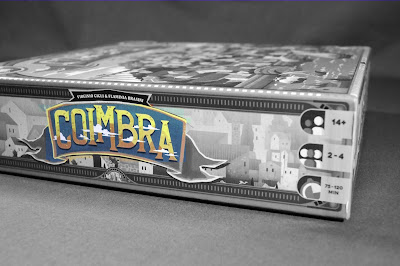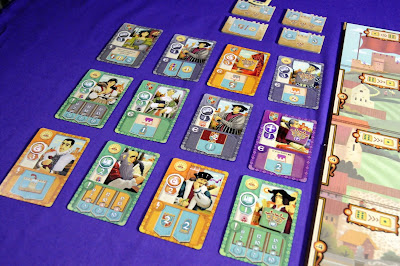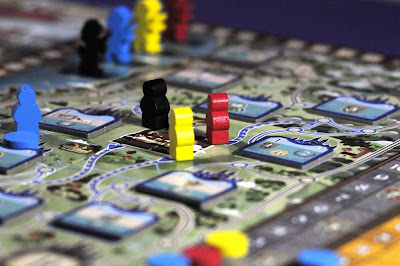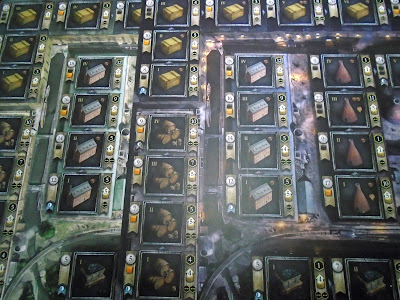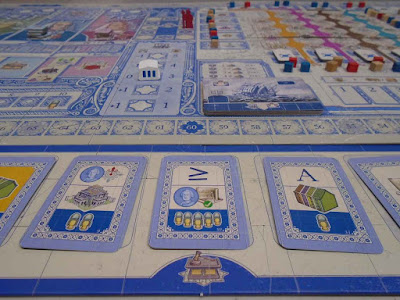ANACHRONY
a review of the board game Designed by Dávid Turczi
Players: 1-4, Time Investment: 30-120 min
Rating:
 |
| I'm Weeping! |
Game Aesthetic
Components
 |
| Meeple Realty's insert to carry these cool crystalline components! |
I cannot get enough of the components in this game! For how complex the mechanics are, and if you've played enough eurogames you would almost fear that with its complexity that the components would look like crap... but they don't! Water is very important in this game -- I'll explain later -- and they did not skimp on that either since it looks crystallized and sparkly. Even the tactile experience of holding the water droplets is fun as they are smooth. Though, it does require a little dexterity because of their smoothness but that's the only downside.
 |
| Different paths lead you to different strengths and weaknesses in the game. Make sure to play to them! |
There are different variable player powers assigned to specific colors, and each of those paths have a different set of mechs. They have lots of detail down to the buttons and wiring on the outside of the suits. If I were patient enough, it would be a great painting project.
 |
| Points and Power Cores are also just simple cardboard. |
A bit lackluster though, are the advancement tiles which -- while shaped differently with interesting hieroglyphs and symbols -- are just basic cardboard. Other basic cardboard pieces are points and power cores, which makes sense because you don’t really interact with these items as much as you do the other resources.
The exception to the cardboard complaint is the heavy cardboard used for the buildings placed into the tableau, just for the aesthetics and not for actual functional purposes. Despite the nice translucence of the water droplets, the cube colors are terrible to see when placed in the mining area. I'm disappointed that this was overlooked because distinguishing these resources is important when building up the tableau. I've seen games where someone mistook one color for another and had to rethink their entire plan as a result. When playing with other people, I've noticed they’ll often opt out of the pretty cubes and instead use the cardboard because the colors will match the building print quality.
 |
| Boring Advancement Tiles. |
I know this isn’t part of the standard game but I did bite the bullet and grab the Meeple Realty custom wood insert, and it really does cut down on the setup as well as just putting the massive game back into the box. Several eurogames do design their boxes such that you could just throw everything into the box but this box requires such pack mastering that this insert saves you the frustration as well.
 |
| Mechs Ready to Deploy and Werk |
Artwork by Villő Farkas, László Fejes, Laslo Forgach, Márton Gyula Kiss, Péter Meszlényi
The background images in this game, like on the gameboard or on the personal player board are gorgeous but the employees that sit in the mechs are super ugly. Of course, nothing compared to some of those games out there that have faces that are the stuff of nightmares. I suppose we do need to give some free passes because of the small space allocation, since the leaders look great but get a whole card to themselves. For the buildings, the symbology is thankfully straight forward but nothing special in terms of execution. Though, if you're used to dry euros like I am it's not a big deal. Standardization for symbology and iconography makes learning games much easier!
Overall, I enjoy the futuristic color palette, use of ethereal outlining, fading and otherwise cloudy weather design for this game.
Overall, I enjoy the futuristic color palette, use of ethereal outlining, fading and otherwise cloudy weather design for this game.
The First Turn
Options
It's worker placement! So, place a thing, do a thing or get a thing. It's very easy to understand that minerals and resources are tight as well as important since the moment you build a building you'll notice in your resource pool that suddenly you're poor. Naturally, most everything requires water, especially when "waking up" employees to man the buildings or the mechs.
As far as guidance goes, the escape conditions in this game -- because who doesn't love a crisis -- are a good place to look for strategy. Other even more straightforward and arguably attainable guides are the public goals though those are never guaranteed points at the end of the game.
Timing is very important; superprojects that have significantly greater rewards for the resource investment in terms of abilities and points can only be invented and built within the time period they belong in. So you may need a time machine before you can get to build one of these bad boys.
Speaking of time travel, when requesting goods and employees from the future (i.e. think of them like short term loans) it's important to know what you're going to do with it. Considering you will need to eventually go back in time to pay those loans back, you need to ensure that your plans include a way to generate that good or hire that person so you can throw them back from whence they came.
 |
| These are your options to borrow from the past for your glorious future. Borrow wisely! |
Note that this game is merciless in that there are no free actions really to take if you haven't planned well. If you did not allow yourself some amount of flexibility, then it's entirely likely that you've accidentally loaded too many mechs with nothing for them to do because they have nowhere to go do the work you need them to do.
Rewards and Objectives
It's also very clear that responsible time travel (i.e. paying back those loans) is important because the more you owe the past (i.e. paradoxes) the higher risk for being hit with anomalies.
 |
| Go back in time, make stuff, get water, or do random things in your tableau! But watch out for those anomalies... |
From my experience playing this game, public goals seem to just be the edge you need to win rather than the guaranteed way to win. If you didn't have a strong majority of your time in the game directed towards one of these goals then you should call it early and move on to something else.
Ability to Pivot
Since a majority of this game is focused on your tableau, your pivot ability is limited and irreparable from bad choices. This is especially aggravated by the (mostly) set number of rounds. These buildings on your tableau require personnel but do not require mechs, so it's necessary to have a good hiring strategy early on.
Not building a way to create resources stifles your growth since buildings require a smattering of resources depending on what part of the tableau they live under, and you can never guarantee time or availability in the mines.
Some opponents I've seen during my plays of this game have stretched out their escape in hopes to net out on the -3 penalty chip and gain a few more points. This tends to give the edge, as the scores are typically close in this game and not disparate.
 |
| Get those points and GTFO! |
Game End
Right before the end of the world, the spots for the workers will work just one more time with an incentive but the players need to ensure that they are sending out mechs during this stage with intention and not haphazardly forcing the end of the game. Though, I have seen those in the lead push the end just to snag the win, which is perfectly fine but difficult if you haven't done the math on the opponents' player boards already.
Then planet blows up, so you finally evaluate how well you performed while on the planet since the escape points have already been accounted for. Public goals, tableau, sets of advancement tiles as well as points generated and acquired during the game will all factor into your victory or loss.
Then planet blows up, so you finally evaluate how well you performed while on the planet since the escape points have already been accounted for. Public goals, tableau, sets of advancement tiles as well as points generated and acquired during the game will all factor into your victory or loss.




